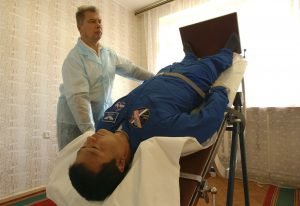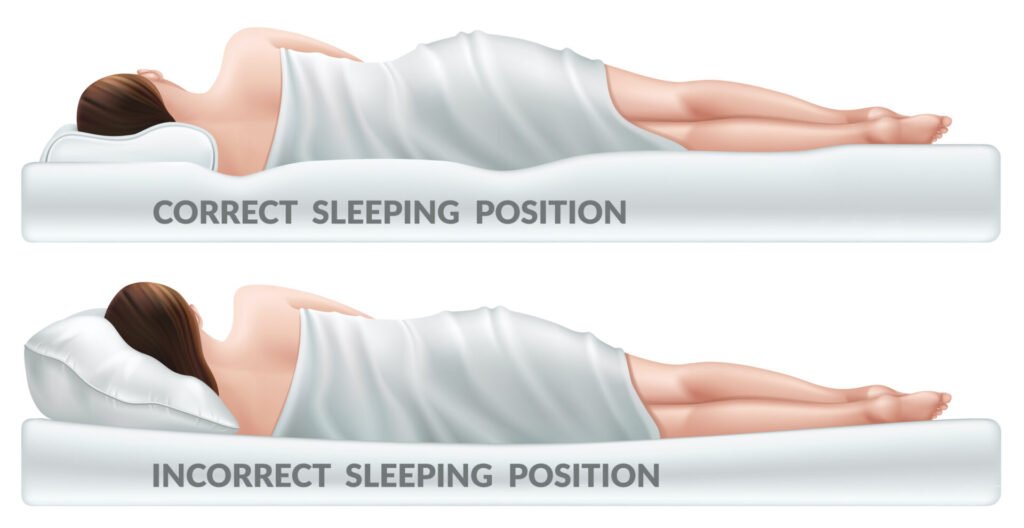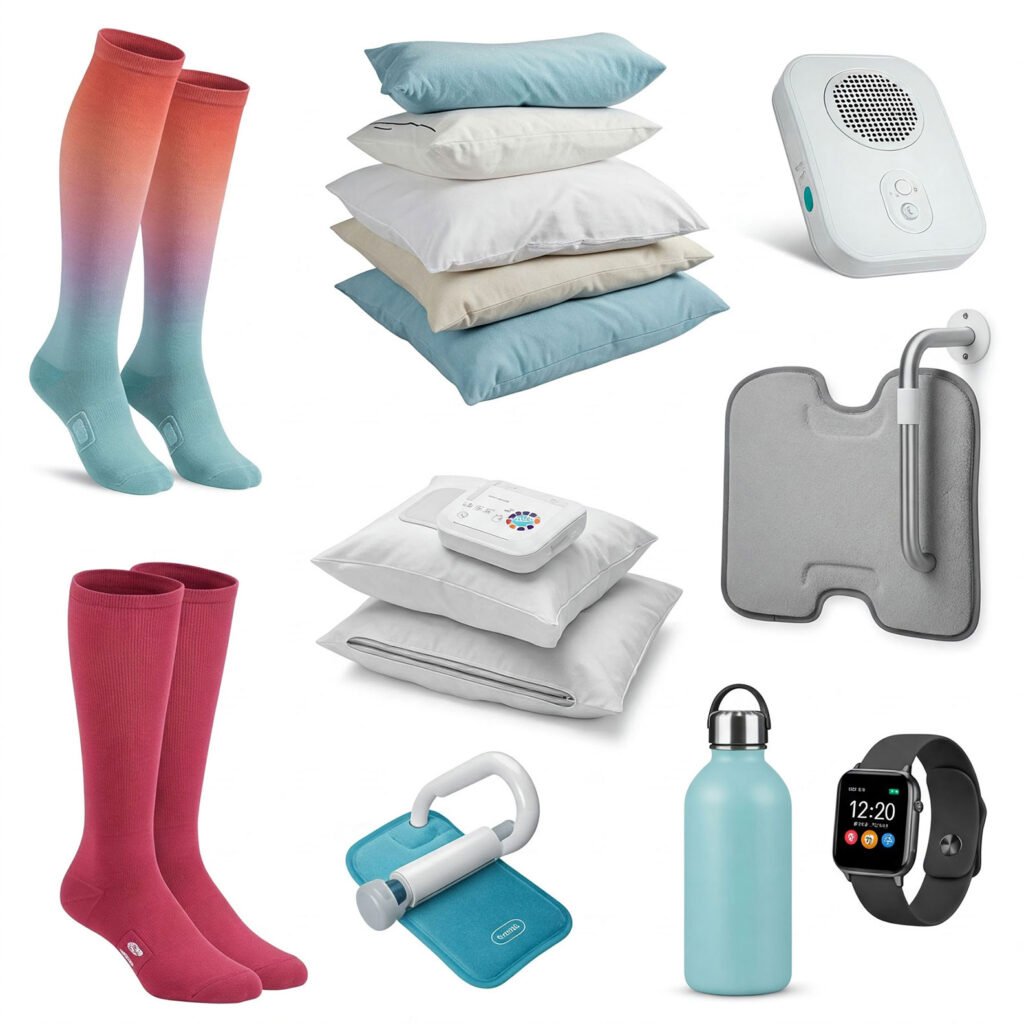How Sleep Position Affects POTS Symptoms
The Impact of Circulation Disruptions During Sleep
The body’s ability to regulate blood pressure and heart rate overnight is compromised in POTS patients, making morning symptom severity noticeably worse. Beds and Pillows for POTS can help. Postural Orthostatic Tachycardia Syndrome (POTS) is a condition that affects blood circulation and autonomic function, leading to dizziness, tachycardia, and fatigue—symptoms that often peak upon waking.
During sleep, gravity plays a crucial role in circulation. Without adequate elevation, blood pools in the lower extremities, resulting in morning lightheadedness, weakness, and difficulty standing. Implementing strategic sleep positioning can help regulate overnight circulation, reducing autonomic strain and improving overall function upon waking.
Benefits of Adjustable Beds for POTS
Customizable Sleeping Positions
Adjustable beds provide flexible elevation settings, allowing users to tailor their sleep posture for circulatory stability and symptom relief. Elevating the upper body promotes blood return to the brain, reducing orthostatic intolerance and minimizing dizziness upon waking. Individuals can experiment with variable incline angles to find the optimal position that enhances comfort and autonomic balance.
Do you time your meals to manage your symptoms?
Circulatory Support and Blood Flow Regulation
Maintaining a slightly elevated sleep posture prevents blood pooling in the lower extremities, a common issue for POTS patients. Adjustable beds aid venous circulation, helping the body regulate blood pressure more effectively overnight. By supporting muscle relaxation and reducing cardiovascular strain, users may experience fewer tachycardia episodes and improved symptom control throughout the day.
Additional Features for Comfort
Many modern adjustable beds include specialized functions that enhance symptom management and overall sleep quality:
Zero Gravity Mode
- Elevates the legs and upper body to create a weightless sensation, reducing pressure on joints and promoting circulation.
- Minimizes strain on the autonomic nervous system, allowing for deeper, more restorative sleep.
Massage Functions
- Provides gentle vibrations or targeted muscle stimulation, improving blood flow and reducing stiffness.
- Helps relax muscles prone to tension or discomfort, aiding overall recovery.
Memory Presets
- Allows users to save preferred sleep positions, ensuring effortless adjustment for consistent symptom relief.
- Reduces time spent reconfiguring settings each night.
Optimizing sleep with adjustable beds tailored to individual needs can significantly improve daily function, circulation, and symptom stability for those with POTS.
Using Wedge Pillows to Improve Circulatory Stability
How Wedge Pillows Aid Blood Flow
Wedge pillows offer a practical and cost-effective solution for optimizing sleep posture without needing a full adjustable bed. By gradually elevating the upper body, they support circulatory regulation, reducing overnight blood pooling that often worsens POTS symptoms upon waking. The gentle incline enhances venous return, preventing the sudden drop in blood pressure that leads to dizziness when transitioning from lying down to standing.
Positioning Techniques for Maximum Effectiveness
Upper Body Elevation for Brain Circulation
Placing a wedge pillow under the upper torso encourages blood flow to the brain, reducing morning dizziness, brain fog, and tachycardia episodes.
- Maintain a comfortable incline, typically between 10-30 degrees, to prevent excessive strain on the neck and spine.
- Opt for high-density foam models that provide firm yet supportive elevation without shifting during sleep.
Leg Elevation for Blood Flow Regulation
Using a separate wedge pillow under the legs helps prevent fluid retention and supports vascular stability.
- Elevating the legs encourages better venous return, minimizing swelling and pooling in the lower extremities.
- Adjustable wedge designs allow for customized positioning, ensuring a balance between comfort and circulation enhancement.
Maximizing the Benefits of Wedge Pillows
To further improve circulatory function and autonomic balance:
- Pair upper-body elevation with compression garments for additional vascular support.
- Hydrate adequately before bedtime, maintaining optimal blood volume overnight.
- Combine leg elevation with gentle stretching exercises to enhance circulatory efficiency before sleep.
By strategically using wedge pillows, individuals with POTS can achieve better autonomic stability, minimizing morning discomfort and circulatory disruptions for a smoother start to the day.

Using Other Pillows to Improve Body Positions While Sleeping
Enhancing Sleep Posture for POTS Management
In addition to wedge pillows, strategically placed support pillows can improve spinal alignment, muscle relaxation, and circulation stability for individuals with POTS. Adjusting pillow placement helps reduce pressure points, preventing stiffness and ensuring a comfortable, restorative sleep experience.
Types of Support Pillows for Better Sleep
Cervical Pillows for Neck and Spine Alignment
- Contoured designs provide optimal neck support, reducing strain from improper head positioning.
- Helps maintain neutral spinal alignment, preventing tension buildup that can contribute to fatigue.
Body Pillows for Full-Body Stability
- Improves postural support, helping prevent overnight twisting that may worsen circulation.
- Beneficial for side sleepers, ensuring hip and shoulder alignment while reducing pressure on joints.
Knee Pillows for Lower Body Comfort
- Placing a pillow between the knees supports hip alignment, reducing strain on the lower back.
- Helps prevent blood pooling in the legs, minimizing morning swelling and discomfort.
Cooling Pillows for Temperature Regulation
- Gel-infused pillows provide breathable comfort, preventing heat sensitivity and excessive sweating at night.
- Supports stable autonomic function, reducing temperature-related symptom flares.
Optimizing Pillow Placement for Circulatory Stability
To enhance blood flow regulation and autonomic balance, consider:
- Using a cervical pillow to prevent neck strain while maintaining upper-body elevation.
- Pairing knee pillows with wedge elevation to improve venous return and prevent fluid retention.
- Adjusting pillow height based on comfort preferences, ensuring optimal postural support throughout the night.
By integrating different pillow types into sleep positioning, individuals with POTS can experience more restful sleep, improved circulation, and reduced morning discomfort.
Selecting the Right Sleep Support for POTS
Factors to Consider When Choosing an Adjustable Bed
Incline Adjustability
One of the biggest advantages of adjustable beds is customizable incline settings. Finding the right elevation can help minimize morning dizziness, improve circulatory stability, and reduce tachycardia episodes. Ideally, individuals should look for models that offer incremental adjustments, allowing them to fine-tune the angle for maximum relief.
Mattress Compatibility
Not all mattresses work seamlessly with adjustable bases. Memory foam and hybrid mattresses are ideal choices, as they mold to the body’s shape while maintaining even support when elevated. Traditional innerspring mattresses may lack flexibility, leading to discomfort or uneven pressure distribution.
Ease of Control
Many modern adjustable beds feature wireless remotes, smartphone app integration, and pre-programmed positions to enhance convenience. Selecting a bed with easy-to-use controls simplifies nighttime adjustments, making symptom management more effortless.
Choosing the Best Wedge Pillow for Circulatory Stability
Material Quality
High-density foam wedge pillows offer firm yet comfortable support, ensuring long-lasting durability without sinking or flattening. Investing in quality materials ensures consistent postural elevation, preventing symptom fluctuations.
Angle Optimization
The incline of a wedge pillow plays a significant role in circulatory effectiveness. A gentle incline between 10–30 degrees minimizes strain on the neck and spine, while still supporting blood flow regulation. Adjustable wedge designs allow for customized positioning, catering to individual symptom needs.
Breathability
Heat retention can be an issue with traditional foam pillows, leading to discomfort and nighttime sweating. Cooling gel-infused models help regulate temperature, keeping individuals cool and comfortable throughout the night—an essential factor for those with POTS-related heat sensitivity.
Choosing Other Pillows for Positional Stability
Using additional pillows can enhance sleep posture, providing better spinal alignment, muscle relaxation, and circulation support for individuals with POTS. Different pillow types address specific positioning needs:
- Cervical pillows – Support neck alignment, reducing tension and strain.
- Body pillows – Stabilize side-sleepers by maintaining hip and shoulder balance.
- Knee pillows – Prevent blood pooling by promoting proper leg positioning.
- Cooling pillows – Regulate temperature, minimizing heat sensitivity issues.
Incorporating targeted pillow placement ensures comfortable and effective sleep posture, improving overall symptom management.
Optimizing Sleep Support for Long-Term Symptom Management
To make the most of adjustable beds and wedge pillows, consider:
- Gradual incline experimentation to find the best angle for relief.
- Pairing sleep support tools with hydration strategies for improved circulation.
- Using breathable materials to maintain comfort and prevent overheating.
Tailoring sleep support solutions to individual symptom needs can significantly enhance nighttime recovery, autonomic regulation, and overall well-being for those managing POTS.

GnarlyTree | DIAGNOSTIC TESTS & CARE
Tilt Table Test | A Key Diagnostic Tool for POTS
Understanding the Tilt Table Test for POTS The Tilt Table Test is a crucial diagnostic procedure commonly used to identify Postural Orthostatic Tachycardia Syndrome (POTS), a form of dysautonomia. Patients...
Frequently Asked Questions
Why does sleep position affect POTS symptoms?
Sleeping flat can cause blood pooling, leading to increased dizziness and orthostatic intolerance upon waking. Elevation improves circulation, venous return, and overall symptom stability.
What is the best incline for sleeping with POTS?
A 10-30 degree incline is generally recommended, but exact needs vary based on individual symptoms and comfort preferences.
Can wedge pillows replace an adjustable bed?
While wedge pillows provide elevation, adjustable beds offer customizable angles for more precise symptom relief and comfort.
Should I elevate my legs or upper body for POTS?
Upper body elevation supports venous circulation and reduces dizziness, while leg elevation helps prevent fluid retention. Some individuals benefit from both adjustments.
How do I choose the right adjustable bed?
Look for customizable incline settings, mattress compatibility, and ease of control to maximize comfort and circulatory support.
What type of wedge pillow is best for POTS?
Choose high-density foam for firm support, a gentle incline (10-30 degrees) for circulation stability, and breathable materials to prevent overheating.
Are cooling pillows useful for POTS?
Yes! Cooling gel-infused pillows help regulate body temperature, preventing heat sensitivity and excessive sweating at night.
How can body pillows help with sleep posture?
Body pillows stabilize the spine, hips, and shoulders, preventing overnight twisting and reducing pressure points for more comfortable sleep.
Does knee elevation help with POTS symptoms?
Placing a pillow between the knees promotes proper spinal alignment, reduces blood pooling, and helps prevent morning swelling and discomfort.
What’s the best way to optimize sleep support for POTS?
Pair adjusted sleep positioning with hydration strategies, compression therapy, and breathable materials to improve circulatory function and autonomic regulation.
Final Thoughts
Optimizing sleep posture with elevated beds, wedge pillows, and supportive accessories plays a crucial role in managing POTS symptoms effectively. By tailoring sleep positioning to individual needs, individuals can experience improved blood circulation, reduced morning dizziness, and enhanced sleep quality, setting the foundation for better daily function.
Balancing comfort, incline, and circulation support ensures autonomic regulation remains stable, reducing symptom flare-ups and promoting greater independence throughout the day. Investing in customized sleep solutions provides long-term relief, making mornings easier and overall well-being more manageable for those navigating POTS.



